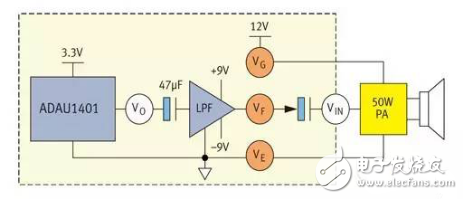As multimedia technology is gradually adopted by in-vehicle electronic devices, digital signal processors have also gained wider and wider applications for digitizing audio signals. For example, in-vehicle multimedia systems replace traditional car radios and CD systems, and DSPs in in-vehicle multimedia systems, such as ADI's ADAU1401 SigmaDSP, deliver superior sound and flexibility for a rich multimedia experience for passengers. In addition, these DSPs provide a useful tool for reducing system noise and power consumption, which is beneficial for system engineers who are concerned with noise and power issues.
The ADAU1401 is a complete single-chip audio system that includes a fully programmable 28/56-bit audio DSP, analog-to-digital converter (ADC), digital-to-analog converter (DAC), and microcontroller-like control interface. Signal processing includes equalization, bass boost, multi-band dynamic processing, delay compensation, speaker compensation, and stereo sound field widening. This processing technology is comparable to the effects of high-end studio equipment, and can compensate for distortion caused by the practical limitations of speakers, power amplifiers, and listening environments, thus significantly improving sound quality.
With the easy-to-use Sigma Studio development tools, users can graphically configure signal processing flows using different functional blocks, such as biquad filters, dynamic processors, level control, and GPIO interface control. Unlike portable devices, car audio systems are equipped with high-power amplifiers, each capable of delivering up to 40W-50W, with at least four speakers per car. Due to the high power, the noise layer is easily amplified, making the human ear feel in a quiet environment. For example, assuming a speaker sensitivity of approximately 90 dB/W, a 1 mV rms noise in a 4 Ω speaker can produce a sound pressure level (SPL) of approximately 24 dB, which can be felt in a quiet environment. There are many possible noise sources, as shown in Figure 1. The main noise sources include power supply noise (VG), filter/buffer noise (VF), and noise VE caused by improper power supply grounding. The VO is the audio signal from the processor, and VIN is the audio input signal of the speaker power amplifier.

Figure 1: Example of a noise source for a car audio system.
Burst during power switch
Car audio power amplifiers typically operate from a single 12V supply, while DSPs require a low-voltage power supply (such as 3.3V) and the filter/buffer may be powered from dual supplies (eg ±9V). Coupling capacitors must be used to provide signal isolation between portions of the circuit operating at different supply voltages. During power on/off, the capacitor is charged/discharged at an extremely fast rate, and the resulting voltage jump propagates along the signal chain, eventually causing the speaker to pop. Figure 2 shows this process.

Figure 2: The principle of the speaker producing a pop.
While knowing the sources of noise layers and pops, and also trying to use good circuit design and place-and-route techniques, as well as selecting better components with lower noise to reduce noise at the source, there are still many uncertainties that can occur during the design process. . Designers of automotive multimedia systems need to deal with many complex issues, so high levels of analog/mixed-signal design skills are required. Even so, the performance of the prototype product may still be inconsistent with expectations. For example, a noise level of 1 mV rms poses a huge challenge. As for popping, existing solutions use MCUs to control the timing of the power amplifier during power switching, but when the processing unit is far from the power amplifier, place and route and electromagnetic interference (EMI) pose potential problems.
We make OBD connector with terminal by ourselves, soldering type and crimping type are both available. Also 12V and 24V type. OBD1, OB2, J1939, J1708, J1962, etc. Also molded by different type, straight type or right-angle type. The OBD connector cables used for Audi, Honda, Toyota, BWM, etc. We have wide range of materials source , also we can support customers to make a customized one to replace the original ones.
OBD Connectors,Sae J1708 Connector,Sae J1939 Connector,OBD2 Diagnostic Connectors,Diagnostic Connector,Deutsch Diagnostic Connector
ETOP WIREHARNESS LIMITED , http://www.oemwireharness.com